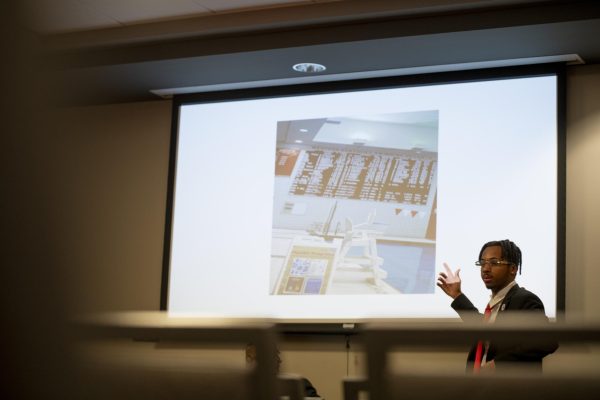Rushing the exit doors: Who is leaving C-USA?
Illustration by Alex Cox
September 20, 2021
The Big 12 Conference officially extended invitations to American Athletic Conference members UCF, Houston and Cincinnati as well as independent BYU on Friday, Sept. 10.
The four programs are joining a conference that has already been fully ransacked – the Big 12 put up its ‘we’re hiring’ sign after Texas and Oklahoma unceremoniously announced their planned departures to the SEC back in July.
The loss of Cincinnati, UCF and Houston leaves three sizable vacancies in the heart of the AAC. What does this have to do with WKU? I’m glad you asked.
The Hilltoppers currently reside in a hodge-podge pile of programs left over from the last wave of realignment. Officially known as Conference USA, it’s a spunky little family that may not be around much longer once realignment kicks into overdrive. This is the island of misfit toys in the world of NCAA DI college sports.
Take a look at a map of C-USA’s member schools. You’ll notice very quickly that these teams share zero geographical ties. Four schools from Texas, UTEP, UTSA, Rice and North Texas, are thrown in the same group as a team from Virginia, Old Dominion, and a pair of Florida programs in FAU and FIU. The distance between the two furthest conference members, ODU and UTEP, is over 1,700 miles.
This conference has no identity.
Take a look at some other conferences. The Sun Belt is composed of scrappy, smaller schools in the American south that proved they had what it took to play in the upper level of the NCAA. It’s not nicknamed the ‘Fun Belt’ for nothing.
The Mid-American Conference, while not known for its successes, has still carved out its own niche of consistent, gritty play that earned the conference its ‘MACtion’ nickname.
C-USA has nothing going for it, and every athletic department in the conference should be hitting the phones to find another conference. Realistically, which C-USA programs have a shot of moving to a new home? Let’s examine all 14 C-USA members to see who deserves a promotion.
Rice
The Owls are immediately off the list. The little Houston private school has a student enrollment of less than 8,000 and the university has few athletic highlights. The Owls do have a solid baseball program but little success to speak of in revenue-generating sports.
Old Dominion
Old Dominion has neither the name recognition nor athletic success to warrant a move up the ladder. Norfolk, Virginia doesn’t have the right culture for the Sun Belt and the program’s only major successes have come from its field hockey team. The Monarchs are stuck in C-USA for the foreseeable future.
Middle Tennessee
Middle Tennessee has little chance of upward movement. The program has no real name recognition, the school hasn’t racked up enough major wins in revenue-generating sports and the most you can say about the Blue Raiders program is that ‘they exist’.
WKU
It hurts to say it, but WKU is destined to stay in C-USA just like its rival MTSU. The Hilltoppers have fielded some solid-to-great football and basketball programs over the last decade and the volleyball program has racked up more accolades than you can count, but WKU lacks the pull needed to jump up the conference ranks.
Perhaps a return to the Sun Belt can be arranged, but that’s about all the Hilltoppers can do.
Marshall
Marshall is in the same boat as MTSU and WKU, save for more name recognition and history. The Herd have won a pair of FCS championships and feature famous alumni such as NFL hall-of-famer Randy Moss, but besides winning the 2020 NCAA soccer championship the program has little to entice larger conferences.
Southern Mississippi
The only way Southern Miss leaves C-USA is if the Golden Eagles can wrench their way into the Sun Belt. The program has remained in the conference since 1997 and strung together a stretch of great football teams in the mid 2000’s, but the little program from Hattiesburg, Mississippi has no real leverage to move up.
Florida Atlantic
The other program in the conference that uses an owl as its mascot, FAU is located in Boca Raton, Florida and has been able to attract big-name talent to its program over the years in football head coaches Howard Schnellenberger and Lane Kiffin.
Unfortunately for FAU, FIU would most likely be picked to move up over the Owls. FAU consistently trots out a solid baseball program year after year, but the school doesn’t have enough going for it to warrant a move to a bigger conference.
Charlotte
Charlotte was a member of the old C-USA before major conference reshuffling in the early 2000’s placed the 49ers in the Atlantic 10 Conference. The school has no major athletic achievements and only just restarted its football program in 2013.
On the other hand, the program is located in a major metro area and boasts an enrollment of close to 30,000 students, so a jump to another home is possible.
UTEP
The University of Texas-El Paso is a sleeper pick to break away to the Mountain West Conference. Much like their divisional rival UTSA, the Miners are located in a major Texan city and play their football games in a massive stadium – the Sun Bowl, which seats 51,500.
The school also won an NCAA Men’s Basketball championship back in 1966, becoming the first team to start five African American players in a title game. The little program laying out in the El Paso sun holds more history than the average fan might think and the Miners could turn some heads during conference realignment.
North Texas
The North Texas Mean Green don’t have too many athletic highlights, save for recent success in men’s basketball. North Texas’ saving grace is its location – the Mean Green are located in Denton, Texas, just outside of Dallas. UNT also boasts the second-highest enrollment in the conference at nearly 40,000 students. The Mean Green could slot into the AAC due to these factors.
UTSA
The University of Texas-San Antonio is often overlooked. Yet, the Roadrunners are located in the second-largest city in Texas. The Roadrunners also play their football games in the Alamodome, a facility that seats 72,000 people and ranks as the largest stadium in C-USA. UTSA is primed for a surprise jump to the Mountain West.
LA Tech
The LA Tech Bulldogs are constantly fighting LSU, ULM-Monroe and Louisiana University for talent, but the little program from Ruston, Louisiana has still managed to field strong athletic programs across its history. The football program won all of its bowls from 2014-19 and has won three C-USA West Division championships since joining the league in 2013.
The Bulldogs have proven they have what it takes to compete with larger programs, and a promotion may be in order.
Florida International
The Panthers boast the largest enrollment in the conference and play at the largest university in the state of Florida. FIU would also provide a Florida-based rival for the South Florida Bulls once UCF officially moves out of the AAC. Athletic success is secondary for FIU in this case; it’s hard to turn down a school located in the greater-Miami area.
UAB
The University of Alabama-Birmingham is the C-USA program most deserving of a promotion. The school shuttered its football program back in 2014, but the Blazers returned to the gridiron just two years later and won a C-USA championship in 2018.
The Blazers have had to fight for every inch, but it’s about time they receive some recognition for their efforts.
Sports Editor Jake Moore can be reached at [email protected]. Follow him on Twitter @Charles_JMoore.


























